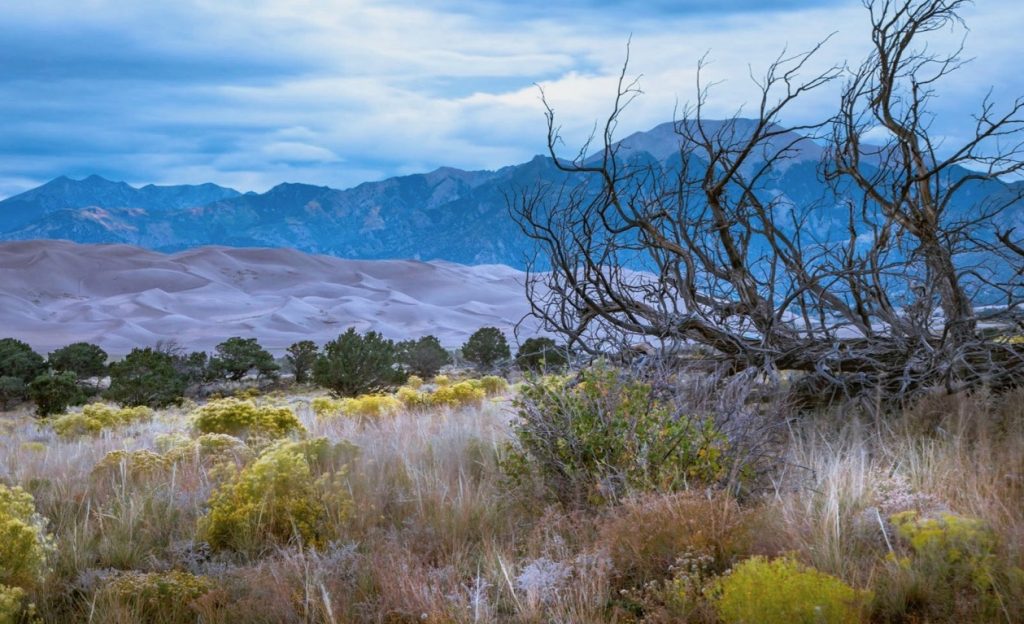I was a college freshman taking a course called “Writing the Natural History Essay.” At 80 years old, with pearl earrings and perfectly coiffed hair, the instructor, Ann Zwinger, both did and did not bring to mind my grandma in suburban Connecticut. Here was a woman who authored a dozen-plus acclaimed books about rugged Western lands. Here was a woman who ran whitewater rapids on the Green River. Here was a woman who tromped around like a kid, twisting her ankles in gopher holes, laughing.
We were on a field trip in Colorado’s San Luis Valley—Great Sand Dunes National Park to the south, the toothy Sangre de Cristo Mountains biting at the horizon to the east. The sun was low, the entire world gilded.
I’ll never forget the “homework assignment” Ann gave us that evening, her outstretched arm gesturing toward the surrounding immensity: Find a place, a gully or rock or shrub, and spend as much time there as you can over the next four days. Sleep there. Eat your meals there. Root yourself to the place. Get bored. Get tired. Get cold and confused. See it from all angles. Notice everything. Journal it down. This is how you will find your essay.
It turns out that when you follow Ann’s advice, you find much more than a dinky essay could ever hope to hold. In my case, I found the mysteries of an ancient fallen juniper and 1,000 variations of light. I found a snowstorm at dawn. I found pebbles. I found vast blank times and the textured richness inside vast blank times. I found a dialogue with the broader environment—listening and responding, listening and responding, zero words exchanged.
The juniper was a hard seat, a friendly seat, a seat on a boat voyaging the ocean of sagebrush, day after day. I spent the bulk of a week riding it, never once trimming the sails or adjusting the tiller, just going wherever the drift wanted to take me. And when the field trip concluded—well, I had changed.
Which is to say I found a way of life out there, a practice to see me through the weeks and months and years to come. Ann confirmed the hunch that had been growing in me since I was a boy aimlessly exploring Grandma’s backyard in suburban Connecticut: Pick a place, hang tight, notice everything. Sit, wait, find. What else is there to do, really, with your sweet fleeting threescore and ten?
By now in this little story, perhaps you’re detecting how close Ann’s advice is to that of countless Buddhists, past and present. As a naturalist, she was primarily focused on the external landscape of flora and fauna, whereas the meditating nun is primarily focused on the internal landscape of thought and emotion—sure, surface differences exist, but the underlying similarity is solid. The naturalist and the nun share a basic commitment to attention, a passion for paying attention to what is. Butterflies, desires, soils, fears, cycles of decay and regeneration, cycles of psyche: it’s all of a piece.
Ann suffered a stroke about a year after teaching my class, and she passed away a decade later—passed back into the campfire smoke and cold wind and starry darkness whence she came, whence everyone comes. A part of her lives on, though, a special part. It’s not something you’ll find in her books. Rather, it’s the very foundation of those books, the plain earnest practice from which they arose. It’s that “homework assignment,” that strategy for opening yourself to the elemental scene and, simultaneously, to intimate spaces of consciousness. It’s a philosophy: Sit-Wait-Find.
And get this, it’s sneaky-radical, a quiet critique of the frenetic pace and heedless consumption that characterize so much of modern American life. The argument could be made that most of us reside within a culture of Stand-Rush-Buy, right? To settle the bones and breathe deep and gaze at a cloud and feel the juniper or zafu beneath your butt—this is effectively a form of resistance, isn’t it?
But resistance is beside the point. The point is place, any place, and the voyage—sometimes boring, sometimes cold and confusing, always nuanced, textured, rich and enriching, enlivening—that it invites us to take. The point is observing the inner and the outer, their interaction. The point is eavesdropping on that wordless dialogue with environment, that silent dialogue of awareness.
Since my freshman year of college, I’ve returned to the San Luis Valley often, usually with the aim of rediscovering my ancient fallen juniper-boat. Of course, such boats abound there, and I never succeed. Does this so-called “failure” sadden me? Far from it! One of the things that makes the Sit-Wait-Find powerful is its portability, its applicability to anywhere and everywhere. I have sat upon other ancient fallen junipers and each has yielded its own unique experience. Moreover, I have sat on talus slopes and creek banks and wildflower meadows and duff piles and precarious summits and park benches all across the state: Mummy Range to Mesa Verde, Black Canyon to downtown Denver.
I have sat for hours, for days, an 80-year-old woman who both does and does not remind me of my grandma occasionally appearing in memory, gesturing with a sweep of her hand at the surrounding immensity, our inexhaustible gilded world. I have sat this way and will continue to sit this way, in Colorado and beyond—going nowhere, traveling far.
As the naturalist-cum-Soto priest Peter Matthiessen writes in Nine-Headed Dragon River: “In Zen tradition, there is a saying, ‘Only be ready, and the teacher will appear.’”
Thank you, Ann.
Thank you for subscribing to Tricycle! As a nonprofit, we depend on readers like you to keep Buddhist teachings and practices widely available.
